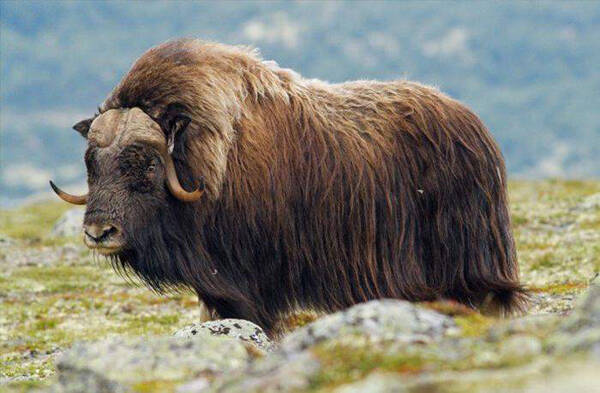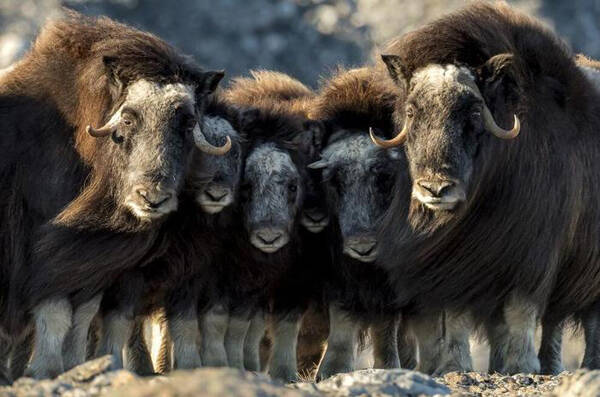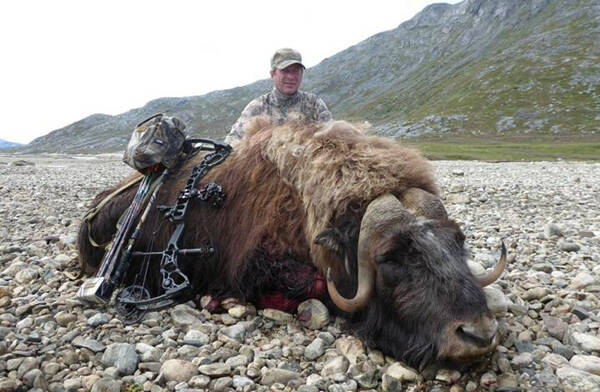Ovibos moschatus
IUCN
LCBasic Information
Scientific classification
- name:Ovibos moschatus
- Scientific Name:Ovibos moschatus,Muskox、Musk Ox,Musk ox, Arctic musk ox
- Outline:Ungulata
- Family:Artiodactyla Bovidae M.Ox
Vital signs
- length:150-260cm
- Weight:180-400kg
- lifetime:20-24years
Feature
The fur of the northernmost ungulate on Earth can grow up to 60 cm
Distribution and Habitat
Distributed in Canada, Greenland, the United States (Alaska), and the Russian Federation.
There are only a few herds of musk oxen in the Arctic region, with a total of about 7,000 heads, which are on the verge of extinction. Although hunting musk oxen is prohibited in Greenland, Canada and other countries and regions, many musk oxen are still hunted crazily. In order to enable this animal to reproduce, many countries have not only strengthened the necessary protection and rescue measures, but also started artificial breeding of musk oxen in Alaska, northeastern Hudson Bay, western Greenland, and even northern Norway.
Musk oxen are a unique species living in the Arctic tundra. In summer, they tend to shelter in moist lowlands, such as river valleys and lakes; in winter, they move to higher slopes, plateaus and places with deep snow accumulation for easy foraging.
Appearance
The body length is 150-260 cm, the tail length is 9-10 cm, the shoulder height is generally 120-150 cm, and the weight is 180-400 kg. Musk oxen have a sturdy body. Females are slightly smaller. The snout and nose are bare, and there is a tuft of hair on the forehead. The eyes are large and round, with purple-blue pupils, and the lips and tip of the tongue are also purple-blue. The two small ears are also covered with hair. The body hair is long, the fluff is thick, and it is dark brown. There is a mane from the nape to the shoulders, which is more than 30 cm long, slightly curly, and hangs down like a cape. The hair is divided into two layers. There is a thick layer of fluff under the long hair, called hair silk, which is both tough and soft, and can block cold and moisture. The upper layer of guard hair can prevent rain, snow and wear. The back of the trunk is a saddle-shaped light-colored hair. The older it is, the more obvious the white area is. The tail is very short and hidden und
Details
Musk ox (scientific name: Ovibos moschatus) is also known as Muskox and Musk Ox in foreign languages. There are two subspecies.

Musk oxen live in rocky and barren places. They live in groups and mainly eat grass and branches of shrubs. In winter, they also dig snow to eat mosses. They are brave and will never retreat or run away under any circumstances. When enemies such as wolves and bears appear, a group of musk oxen immediately form a defensive formation, with small ears covered with dense hair; adult bulls stand at the forefront and surround the calves in the middle. The bulls will launch an unexpected attack and attack the opponent with their sharp horns. Because their hair is long and thick, they can protect their bodies from being bitten by enemy beasts. After the bull attacks, it immediately returns to its original place and waits for battle.
Under normal circumstances, musk oxen appear to be particularly docile. They stop to eat a little food, then lie flat on the ground and chew slowly, and soon they fall asleep. When they are slightly awake, they will move forward for a while, and then repeat the same trick, eating food, ruminating, and falling asleep. In fact, musk oxen do this for a purpose: to reduce energy consumption and reduce food demand. In summer, musk oxen mainly feed on fresh wild grass and drink water from melted streams, ponds, and rivers. In winter, musk oxen only eat a small amount of snow, because they consume calories to melt the snow into water, which not only meets the body's needs, but also reduces energy loss. It is reported that because musk oxen are very efficient in maintaining energy, the food they need is only 1/6 of that of cattle of the same size.
Musk oxen like to live in groups. In summer, they live in smaller groups, foraging for leaves of dwarf willow trees, and in winter, they form large groups of more than a hundred. Usually, young and female musk oxen are in the middle of the team, and strong male musk oxen are responsible for vigilance and protection around them. The male musk oxen form their own unique groups, each with its own "group leader", but all led by an old musk ox (often a pregnant female musk ox). Whenever the team moves forward, there is always a smart and capable male musk ox leading the way, followed by a large group of musk oxen.

Musk oxen are very organized and gregarious animals. When encountering natural enemies, they do not run around in panic like bison, but form a special defense circle. More than a dozen bulls and cows rush to the high ground, shoulder to shoulder, surround the calf in the middle to protect it, face outward, lower their heads, and stare at the enemy. Their main natural enemies are Arctic wolves and polar bears. Faced with a huge body of 300 to 400 kilograms and hard horns (both male and female musk oxen have horns), Arctic wolves and polar bears are often helpless. Sometimes angry musk oxen will rush out of the defense circle and take the initiative to attack.

But when gun-wielding Europeans entered the polar regions and declared war on the musk oxen for their fur, beef, and horns, the oxen’s defenses were not only useless, but worse than a rout. The hunters first sent out hunting dogs to chase the musk oxen, and when the musk oxen angrily formed a defensive circle and prepared to fight to the death, they shot them one by one. This killing was extremely efficient. Around 1865, the last musk oxen in Alaska were shot. By the beginning of the 20th century, musk oxen in Canada and Greenland were also on the verge of extinction. Between 1902 and 1909, American explorer and Rear Admiral Peary led several expeditions to the Arctic, shooting about 600 musk oxen for food and obtaining funds for activities by selling musk ox fur. If the Canadian government had not passed a law in 1917 to ban the hunting of musk oxen, musk oxen might have been extinct long ago. In 1930, the U.S. Congress provided funds to transport 34 musk oxen from Greenland and reintroduce them to Alaska. Under protection, musk oxen reproduced very quickly. There are about 3,000 musk oxen in Alaska and about 80,000 in the world. They are no longer considered endangered animals, and some areas even allow limited hunting of them.
The northernmost ungulate on Earth: In the colder climates of high latitudes, fur is essential for survival. Among ungulates, no animal lives farther north than the musk ox - it can be found in the Canadian Arctic and Greenland at 83°N. Musk oxen have a double coat that protects against temperatures as low as -40°C. The undercoat shed during the annual moulting period is said to be eight times warmer than sheep wool, and the outer protective hair is the longest in the animal kingdom, reaching up to 60 cm in length. (Guinness World Records)
Listed in the IUCN Red List of Threatened Species in 2008 ver3.1 - Least Concern (LC).
Protect wild animals and stop eating game.
Maintaining ecological balance is everyone's responsibility!








